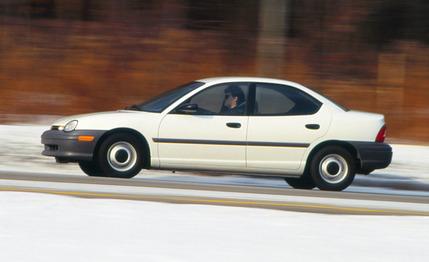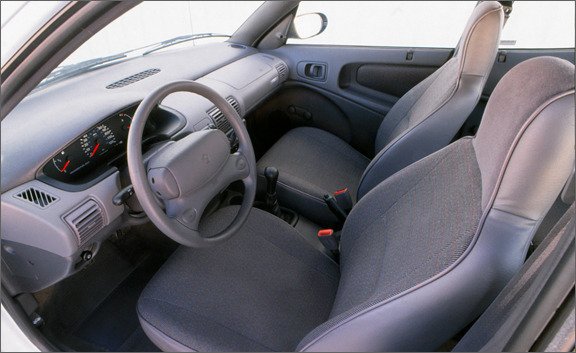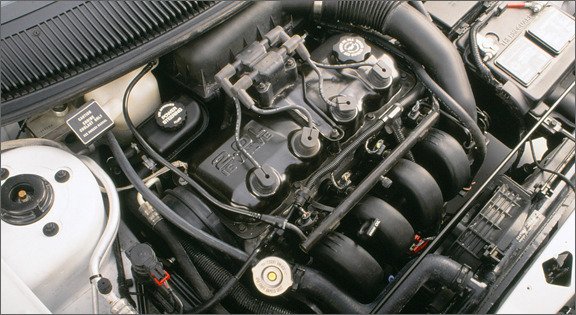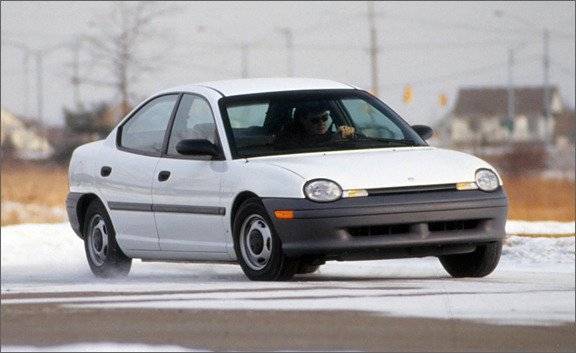
 Archived Road Test
Archived Road Test
First Expert: "Neon is an utterly radical small car."
Second Expert: "Whadaya, some kinda nut? Neon is plain old common sense."
First: "Radical!"
Second: "Sensible!"
First: "Rad!"
Voice Over: "Hold it, you're both right. Neon shows common sense in depth, which is radical for a budget-priced car."
Fade to sage C/D road tester who says: You can set the tone for the whole Neon story with just one number—54.7 inches, the height of its roof. Detroit automakers, and most others in the world, have for years compromised the usefulness of their small cars by putting styling first. Conventional wisdom says that good-looking cars are low-slung cars. The Corvair was low, the Vega was lower. Today, Saturn is low and the Honda Civic is lower. On the downside, the look may be stylish, but the price you pay is a duck of your head required to enter, and coach-class space once you get there.
In a burst of common sense, Chrysler put priority on headroom, then designed a tall car that looks stylish. The Neon is taller than the Civic by three full inches, taller than all of its other mainstream competitors, too. You can get in without taking precautions. You can wear a hat. Is this a radical idea or just common sense?
Whatever it is, there's plenty more of it scattered throughout the Neon. Chrysler says it asked potential customers what they wanted, then kept rechecking with them as the Neon progressed through its development stages. Funny, every carmaker says the same thing, but Neon somehow came out more roomy, more comfortable, more agile, more fun.
First on the Neon's list of radical—common sense?—details is low price. After years of hearing that Detroit couldn't make money on small cars, Neon steps into the ring with a base price of $9457, $850 under the cheapest four-door Saturn, $1450 less than the Escort LX. Wow. And Chrysler insists that Neon will make money.


Okay, base cars are typically too spartan to meet our minimum comfort requirements. Still, price is critical in this end of the market. How low can you go and still feel good about your new Neon? This test is to find out.
Here's a base car with AM/FM/cassette system ($170), floor mats ($46), and the Customer Preferred Group ($1861) which includes air conditioning, power steering, rear defroster, manually adjustable outside mirrors, bodyside moldings, touring suspension, tinted glass, and intermittent wipers. Including a destination charge of $500, the total came to $11,552.
For that we got a plain white five-speed with dog-dish hubcaps, great room inside, dual airbags, and plenty of driving fun. The seat cloth looks a bit frugal, the rear sea is hard as a park bench, and the undamped trunk lid clangs when slammed shut like reject from a cymbal factory. But we still like the car. A lot.
Chrysler says that the customers said they wanted power to pull into traffic and merge onto the freeway. Seems like common sense to us. So all Neons come with a sixteen-valve SOHC 1996cc four-cylinder engine rated at 132 horsepower at 6000 rpm (a twin-cam version of the same engine with about ten more horses will be available later). Hey, let's go merge on the freeway! Standing on the Neon's gas is more fun than anyone would expect of thrifty car. The engine has plenty of torque, so you're never a sitting duck if you get caught with the revs down, and it pull happily all the way to its 6500-rpm redline (tachometer is available on higher-level Neons). Sixty mph comes up from a standing start in a speedy 7.9 seconds. Top speed is limited to 116 mph.
The five-speed works fine, with low-effort shifts and a reasonably rewarding feel, although not much sense of machinery gets through the cable linkage. We're also pleased to report that the accelerator and brake pedals are nicely located for heel-and-toe operation, although this part is more car sense than common sense.
Four-cylinder engines can be thrashers (GM's Quad Four) or they can be sweet (the typical Honda). The base Neon is not quite Honda silky, nor Honda silent, but it's close enough for now. Higher-priced Neons have more sound deadener, which puts them among the best of Detroit's four-cylinder powerplants.


Base Neons get budget tires too—Goodyear Invicta GS 165/80R-13s—which have less grip on the road and less refinement in their steering feel than others on the option list. It's rare that a car of this class gets flung around enough to approach the tires' limits. This Neon, though, encourages spirited driving, and its handling is well balanced, with good suspension travel, in any normal road maneuver. Grip on the skidpad measured 0.77 g. The "touring suspension" option included in the Customer Preferred Group is, in fact, standard equipment on the uplevel models, so it's hardly a high-performance option.
Until the coupe goes on sale in summer, Neons come as four-doors only. Common sense says a sedan should be roomy. More than that, the room should be accessible. The Neon earns high marks on both counts. Like recent Hondas and the larger Chrysler LH, Neon has a long wheelbase—for example, seven inches longer than the Toyota Corolla's. This allows the rear wheels to be pushed back so they don't encroach on the rear seat. The cab-forward look, although it's mostly Nineties fashion, has one clear benefit: it allows a high roof to be carried gracefully over the passenger compartment. Headroom, both front and rear, is exceptionally good. Door openings are exceptionally large. And the sills are low. Which means that long-legged males will have an easier time getting their feet and knees aboard Neon than any of its competitors.
The trunk contains 11.8 cubic feet of cargo space. The lid opens down to bumper height for easy loading. Unfortunately, Chrysler stuck with conventional trunk hinges—the kind that bite into hauling space as the lid is closed. Still, common sense abounds. Customers want safety. Two airbags are standard equipment. Anti-lock brakes are available on all models, even the base car. Front shoulder belts have height adjusters at the B-pillar. Future side-impact standards are being met now, with extra beams in the doors and an additional semi-latch low in each rear opening to keep the doors from pushing in on impact.
There are no storage pockets on the door inner panels, the space having been commandeered by crash protectors, but engineers haven't given up hope.
The base car lacks certain conveniences and efficiencies that are standard on up-level models, such as a remote trunk release and a fold-forward rear seatback to enlarge cargo space into the back seat.
But there's still the common sense. For example, the soft-skin plastic steering-wheel rim gets nice and fat at nine and three where you want to take a grip. The speedometer goes to 120 mph like a real car should, instead of pooping out at 85 in supine resignation to bureaucratic tsk-tsking. The heater puts out heat almost instantly, maybe even quicker than Honda, which until now has set the standard. The sun visors have pull-out extensions to lengthen their coverage (although the design seems cheesy). An abbreviated console proffers genuinely useful cupholders.
Can we live with an $11,552 Neon? Yes, very well, thank you. The lesson of the Neon is that common sense makes a really nifty car. Which is bad news for Saturn and other small cars that have relied on low prices. They simply can't measure up for roominess and performance.
Would we prefer a plusher version? Well, yes, and we'll have a test of such a Neon within a few months.
COUNTERPOINT
An old adage says there is no substitute for cubic inches. If so, then the Neon is a success before we even begin, considering stuff like space, of which the Neon has an abundance. Or style, which the car flaunts shamelessly. Or good ergonomics, with which the Neon is generously endowed. But it's the 2.0-liter engine that really sets this car apart, gracing it with plenty of mid-range torque and with enough power to shrug off the weight of four large passengers. The engine alone should scare the Neon's rivals.
—Barry Winfield
Any minor complaints you might have about this little car—you're either going to like its kiddy-car styling, or because it's an "economy" car, you won't care—are tossed out the window the first time you wind out the Neon from second to third gears. It just goes like stink. You find yourself saying out loud, "This is a Chrysler?!" It's flabbergasting how good this little engine is. It makes you want to pull over, open the hood, and locate that Honda or Toyota or Nissan emblem, which isn't there. And how refreshing it is to drive a stick without a tachometer, which puts your ears, after all these years, back to work.
—Steve Spence
Based on its looks, roominess, power, and price, the Neon in blueprint looked to be a winner. But would it be the first Detroit-born econobox with the polish and finesse of the better imports? The shift quality and engine noise in the pre-production cars were not encouraging. The production car shown here has put my concerns to rest. The shifter is light and accurate enough to please a Civic driver. The engine is free of mid-range boominess and high-rpm thrash. The discerning driver on a budget will find much to like in the Neon.
—Csaba Csere

